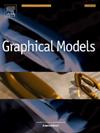高效的四维平面空间RANSAC点云配准
IF 2.2
4区 计算机科学
Q2 COMPUTER SCIENCE, SOFTWARE ENGINEERING
引用次数: 0
摘要
基于点级信息的三维配准方法在噪声、密度变化、大尺度点和小重叠的情况下会产生冲突,而现有的基于原语的三维配准方法在原语提取过程中往往对微小误差很敏感。本文提出了一种可靠、高效的全局配准算法,该算法利用了平面空间而不是点空间中的随机样本一致性(RANSAC)。为了提高假定对应的内嵌比,我们设计了一个基于内平面的描述符,称为凸壳描述符(CHD),以及一个基于平面间的描述符,称为平面特征直方图(PLFH),它们分别充分利用了平面轮廓形状和面向关系。基于这些新的描述符,我们随机选择相应的平面对来计算候选变换,然后进行假设验证步骤来确定最优配准。大规模点集的大量测试证明了我们的方法的有效性,并且与最先进的方法相比,它在效率和准确性方面显着提高了配准性能。本文章由计算机程序翻译,如有差异,请以英文原文为准。
Efficient RANSAC in 4D Plane Space for Point Cloud Registration
3D registration methods based on point-level information struggle in situations with noise, density variation, large-scale points, and small overlaps, while existing primitive-based methods are usually sensitive to tiny errors in the primitive extraction process. In this paper, we present a reliable and efficient global registration algorithm exploiting the RANdom SAmple Consensus (RANSAC) in the plane space instead of the point space. To improve the inlier ratio in the putative correspondences, we design an inner plane-based descriptor, termed Convex Hull Descriptor (CHD), and an inter plane-based descriptor, termed PLane Feature Histograms (PLFH), which take full advantage of plane contour shape and plane-wise relationship, respectively. Based on those new descriptors, we randomly select corresponding plane pairs to compute candidate transformations, followed by a hypotheses verification step to identify the optimal registration. Extensive tests on large-scale point sets demonstrate the effectiveness of our method, and that it notably improves registration performance compared to state-of-the-art methods in terms of efficiency and accuracy.
求助全文
通过发布文献求助,成功后即可免费获取论文全文。
去求助
来源期刊

Graphical Models
工程技术-计算机:软件工程
CiteScore
3.60
自引率
5.90%
发文量
15
审稿时长
47 days
期刊介绍:
Graphical Models is recognized internationally as a highly rated, top tier journal and is focused on the creation, geometric processing, animation, and visualization of graphical models and on their applications in engineering, science, culture, and entertainment. GMOD provides its readers with thoroughly reviewed and carefully selected papers that disseminate exciting innovations, that teach rigorous theoretical foundations, that propose robust and efficient solutions, or that describe ambitious systems or applications in a variety of topics.
We invite papers in five categories: research (contributions of novel theoretical or practical approaches or solutions), survey (opinionated views of the state-of-the-art and challenges in a specific topic), system (the architecture and implementation details of an innovative architecture for a complete system that supports model/animation design, acquisition, analysis, visualization?), application (description of a novel application of know techniques and evaluation of its impact), or lecture (an elegant and inspiring perspective on previously published results that clarifies them and teaches them in a new way).
GMOD offers its authors an accelerated review, feedback from experts in the field, immediate online publication of accepted papers, no restriction on color and length (when justified by the content) in the online version, and a broad promotion of published papers. A prestigious group of editors selected from among the premier international researchers in their fields oversees the review process.
 求助内容:
求助内容: 应助结果提醒方式:
应助结果提醒方式:


